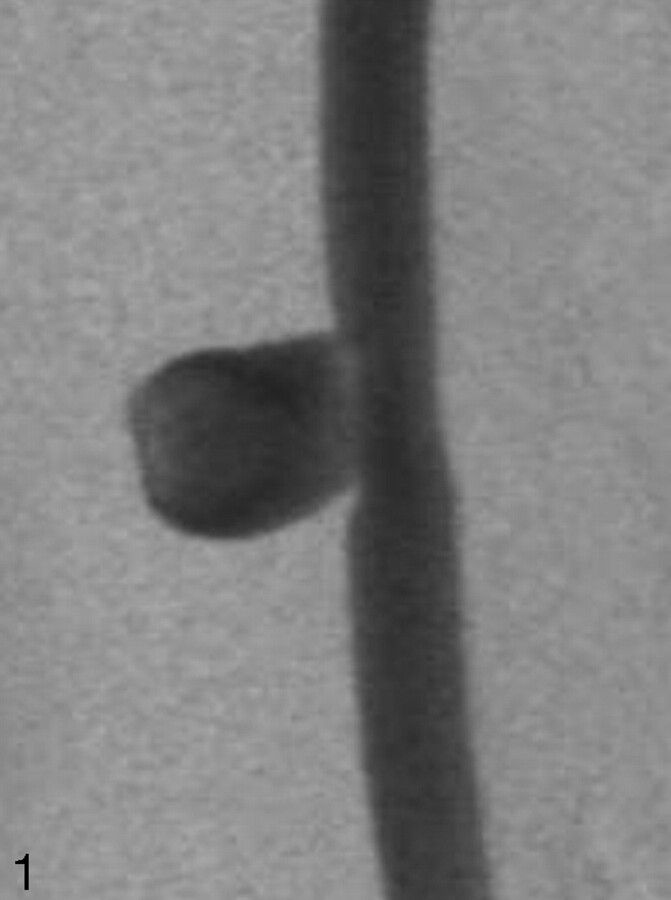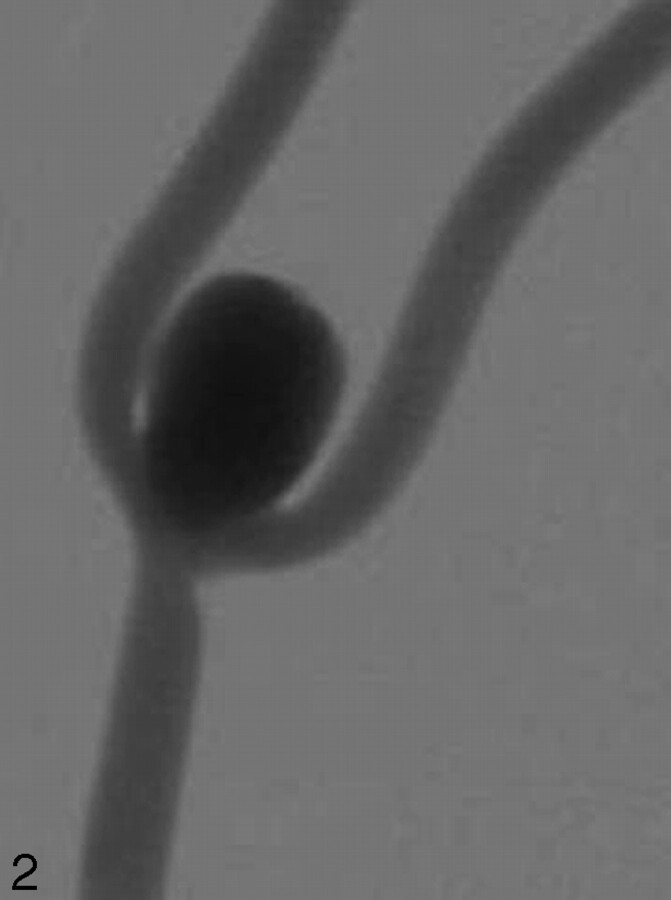Abstract
BACKGROUND AND PURPOSE: The canine vein pouch aneurysm model is widely used for testing and development of devices directed at the endovascular treatment of aneurysms. Our purpose was to determine the incidence of spontaneous thrombosis and rupture of these aneurysms.
MATERIALS AND METHODS: A retrospective review of laboratory records of canine vein pouch aneurysms made during a 6-year period was performed. The aneurysm and parent artery dimensions as well as incidences of spontaneous thrombosis and rupture were noted.
RESULTS: During the interval studied, 326 vein patch aneurysms were made in 310 canines. Of these, 102 were sidewall (lateral) and 224 were bifurcation aneurysms. Spontaneous occlusion occurred in 9 of the sidewall aneurysms and in only 1 of the bifurcation aneurysms. None of the aneurysms ruptured.
CONCLUSION: Spontaneous occlusion of the sidewall canine vein patch aneurysm occurred less than 10% of the time; in the bifurcation aneurysms, it almost never occurred. These characteristics enhance the value of this model for use in testing of devices intended for the endovascular treatment of aneurysms.
The development and preclinical evaluation of devices intended for the endovascular treatment of aneurysms require a variety of models. Since its description by German and Black in 1954,1 the canine vein pouch model has been widely used in such efforts. There is, however, little information regarding its natural history (incidence of spontaneous thrombosis or rupture). With this in mind, we retrospectively evaluated our experience with the model over a 6-year period.
Materials and Methods
Form November 1999 until September of 2005, 326 vein patch aneurysms were made in 310 canines. All procedures were performed under a protocol approved by the University of Wisconsin Animal Care Committee. Operations were performed under sterile conditions. After induction with 5% pentothal, endotracheal general anesthesia was maintained by using 100% oxygen and 1%–2% halothane. The average weight of the animals was 25 pounds. The interval between aneurysm construction and implant of a device ranged between 1 week and 47 weeks, with an average of 10 weeks and a median of 9 weeks.
At the time of device evaluation, all aneurysms were first evaluated with digital subtraction angiography (DSA), by using standard intra-arterial catheter techniques. Laboratory records regarding aneurysm creation and pretreatment angiographic findings were available for all animals; these were reviewed for documentation of aneurysm patency at the time of device evaluation, as well as angiographic measurements of aneurysm and parent artery sizes.
Sidewall (Lateral) Aneurysms
One hundred two sidewall aneurysms were constructed in 86 canines (Fig 1). The technique for making the aneurysms and their hemodynamic characteristics have been previously described in detail.2–4 In all instances, a 4.4-mm vascular punch was used to make the aneurysm ostium. The status of aneurysm patency was documented in all of the sidewall aneurysms. Records of aneurysm dimensions were available in 45 (44%) of these; parent artery dimensions were available in 29 (28%).
Fig 1.
DSA of a typical sidewall canine vein pouch aneurysm.
Bifurcation Aneurysms
Two hundred twenty-four bifurcation-type aneurysms were made in the same number of canines (Fig 2). The technique used for making the aneurysms and their hemodynamic characteristics have been previously described in detail.2–4 Since these descriptions, there has been only 1 modification: to try to standarized the size of the aneurysm, a 10-mm vein pouch is now routinely used. The status of aneurysm patency was documented in all of the bifurcation aneurysms. Records of aneurysm size were available in 153 (68%); parent artery measurements were available in 133 (59%).
Fig 2.
DSA of a typical bifurcation canine vein pouch model.
Results
Sidewall (Lateral) Aneurysms
DSA evaluation was performed in these 86 animals at an average of 74.9 days after aneurysm creation. Eighty-eight (86%) of the 102 aneurysms were patent at the time of pretreatment evaluation. Five (4.9%) contained some thrombus, but enough flow remained to allow them to be used. Nine (9%) were thrombosed. In the 29 animals for which measurements of parent artery size were recorded, the average diameter of the common carotid artery proximal and distal to the aneurysm was 3.4 mm and 3.5 mm, respectively. For the 45 aneurysms for which measurements were recorded, the average aneurysm dimensions were 6.9 mm in height, 6.4 mm in diameter, and 4.7 mm in neck width. There was no record of spontaneous rupture of any of the sidewall aneurysms.
Bifurcation Aneurysms
DSA evaluation was performed in these 224 animals at an average of 66.5 days after aneurysm creation. Only 1 of these aneurysms was occluded at time of pretreatment evaluation (99.5% were patent). Two others showed angiographic evidence of a small amount of thrombus at the dome. This was judged not to be sufficient to prevent their use. Of the 133 aneurysms for which measurement of parent artery size was recorded, the average diameter of the common carotid artery proximal to the aneurysm was 3.7 mm; the average diameter of the continuation of the right common carotid artery distal to the aneurysm was 3.3 mm and that of the left common carotid artery distal to the aneurysm was 3.4 mm. Of the 153 aneurysms for which measurement of aneurysm size was recorded, the average aneurysm dimensions were 10.3 mm in height, 7.7 mm in diameter, and 5.5 mm in the ostium. There was no record of spontaneous rupture of any of the bifurcation aneurysms.
Discussion
This retrospective review of a 7-year experience shows that there is almost never spontaneous thrombosis of the canine bifurcation aneurysm. Spontaneous occlusion of sidewall aneurysms occurred in only 9%, and partial thrombosis, in 5% of our animals. Because of this small incidence of spontaneous occlusion, as well as the need to let complete wound healing occur before implant of a test device in studies looking at histologic response to implants, several weeks’ healing time was allowed between aneurysm creation and use of the animal for device testing. The difference in the incidence of spontaneous occlusion of sidewall versus bifurcation aneurysms is likely primarily related to differences in the hemodynamics, with an important factor causing these differences being the smaller ostium (4.7 mm versus 5.5 mm) and the smaller dome size (10 × 8 mm versus 7 × 6 mm) of lateral aneurysms compared with the bifurcation aneurysms.
These findings regarding the sidewall aneurysms are in agreement with those of an earlier report from our laboratory3 and with that of Kallmes et al,5 who studied the natural history of canine sidewall aneurysms in a small series (8 animals, each with 2 aneurysms). The authors of another recent report found improved patency rates by adjusting their technique to create an oblique angle of the vein graft at the ostium.6 This, however, does change the hemodynamic pattern of the lateral aneurysm. Although patency rates will likely vary between centers and between operators, we have always used a 4.4-mm vascular punch in an attempt to standardize the aneurysm ostium.
To our knowledge, except for the recent description by Yong et al7 of 3 canine bifurcation aneurysms, there is no prior study regarding the natural history of the canine bifurcation aneurysm. We have found that the patency rate is very high and the aneurysms do not rupture spontaneously. Although having an aneurysm model that has a significant incidence of spontaneous ruptures would be desirable, a model that reliably remains patent and does not spontaneously rupture is still quite useful.
Because of its lack of spontaneous thrombosis or rupture, the large vessel and aneurysm size, the ease of performing multiple high-quality angiographic evaluations, and the ease of animal care and handling, the canine vein pouch aneurysm model is valuable for the preclinical study of devices intended for the endovascular treatment of aneurysms. Its widespread use and the significant literature regarding the biologic response of a variety of devices used in this model further enhance its usefulness.
Conclusions
Spontaneous occlusion of the sidewall canine vein patch aneurysm occurred less than 10% of the time; in the bifurcation aneurysms, it almost never occurred. These characteristics enhance the value of this model for use in testing of devices intended for the endovascular treatment of aneurysms.
References
- 1.German WJ, Black PW. Experimental production of carotid aneurysms. N Engl J Med 1954;250:104–06 [DOI] [PubMed] [Google Scholar]
- 2.Graves VB, Partington CR, Rufenacht DA, et al. Treatment of carotid artery aneurysms with platinum coils: an experimental study in dogs. AJNR Am J Neuroradiol 1990;11:249–54 [PMC free article] [PubMed] [Google Scholar]
- 3.Graves VB, Strother CM, Partington CR, et al. Flow dynamics of lateral carotid artery aneurysms and their effects on coil and balloons: an experimental study in dogs. AJNR Am J Neuroradiol 1992;13:189–96 [PMC free article] [PubMed] [Google Scholar]
- 4.Strother CM, Graves VB, Rappe AH. Aneurysm hemodynamics: an experimental study. AJNR Am J Neuroradiol 1992;13:1089–95 [PMC free article] [PubMed] [Google Scholar]
- 5.Kallmes DE, Altes TA, Vincent DA, et al. Experimental side-wall aneurysms: a natural history study. Neuroradiology 1999;41:338–41 [DOI] [PubMed] [Google Scholar]
- 6.Yoshino Y, Niimi Y, Song JK, et al. Preventing spontaneous thrombosis of experimental sidewall aneurysms: the oblique cut. AJNR Am J Neuroradiol 2005;26:1363–1365 [PMC free article] [PubMed] [Google Scholar]
- 7.Yong SS, Yasunari N, Yoshikazu Y, et al. Creation of four experimental aneurysms with different hemodynamics in one dog. AJNR Am J Neuroradiol 2005;26:1764–1767 [PMC free article] [PubMed] [Google Scholar]




